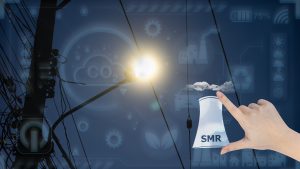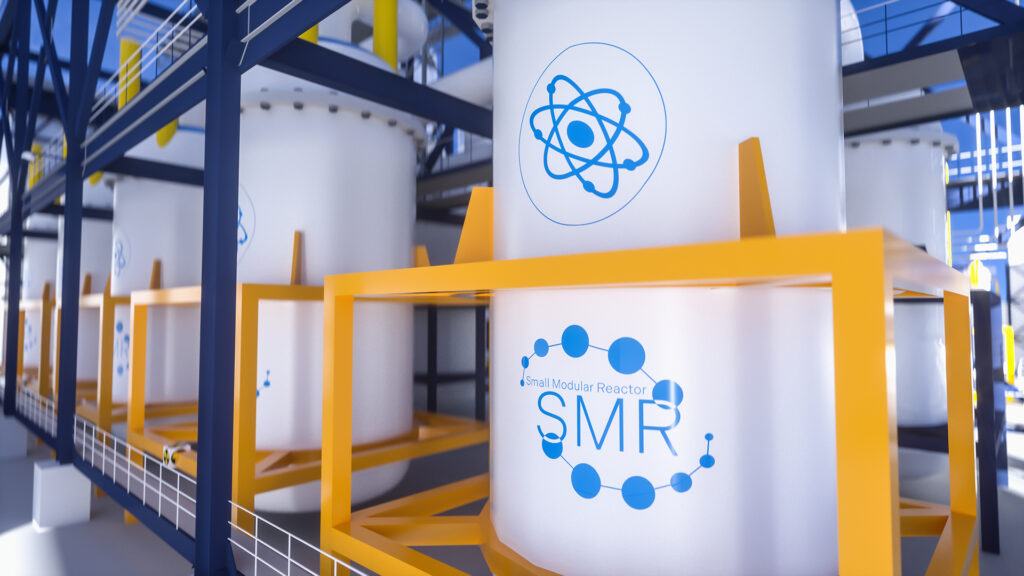The ANITA project is investigating the use of small modular reactors as a sustainable and green alternative for hydrogen production.
One of the promising options to achieve zero greenhouse gas emissions in Sweden by 2045 is the utilisation of hydrogen as an alternative energy carrier. To support this ambition, one of the missions of the ANItA project is to explore using small modular reactors (SMRs) for hydrogen production.
SMRs and their role for clean energy generation
Small modular reactors, as defined by the International Atomic Energy Agency (IAEA), are reactors that are capable of producing up to 300 megawatts of electric power – roughly a third of the output of conventional nuclear reactors. SMRs operate based on the same fission principles as traditional reactors, but they offer several benefits over traditional ones. These advantages include:
Compact footprint: Their small size facilitates their deployment, particularly in isolated or remote regions and countries with limited infrastructure.
Localised deployment: Flexible installation options enable their placement near hydrogen production and refuelling stations, which could help reduce transportation costs for hydrogen distribution.
Scalability: More SMRs can be added to increase power output without the need for new licences, making it easier to meet growing energy demands.
Additionally, SMRs can be built at existing power plant sites, increasing energy capacity without starting from scratch. They can also be integrated with other energy sources, such as renewables, depending on local energy needs, providing a flexible solution for diverse energy demands. SMRs offer advantages over renewable energy sources such as solar and wind due to their ability to provide a continuous power supply 24/7.

These characteristics make them a highly recommended clean energy strategy for both electric and non-electric applications. This article will specifically focus on their role in hydrogen production (a non-electric application), while the electric application has been discussed in detail in the A2 ANItA report.¹
Hydrogen as an energy carrier
Although hydrogen is colourless, various colour codes are used within the energy industry, known as the ‘hydrogen rainbow’, to distinguish between different production pathways. Green hydrogen refers to hydrogen produced from renewable energy sources, such as solar and wind power. On the other hand, pink hydrogen, sometimes referred to as red or purple hydrogen, is produced using nuclear energy. Hydrogen is not an energy source, but just like electricity it is an energy carrier. It can be used in several sectors, such as industry, electricity generation, and transportation.
Status of hydrogen in Sweden today
Sweden consumes a substantial amount of hydrogen, estimated at approximately 6 TWh annually.² Currently, the dominant method of hydrogen production relies on fossil fuel sources, i.e., thermochemical conversion of natural gas accounts for the largest share of hydrogen production, approximately 67%. Only 6% is produced through electrolysis, the rest is produced via residual streams in other industrial processes. However, the economic viability of this approach is increasingly challenged by rising hydrocarbon costs, particularly methane, and the need for carbon capture and sequestration of the co-produced CO2.
On the other hand, the challenges of green hydrogen production are becoming more apparent, particularly in terms of scalability and the high energy requirements for its production. Despite its potential benefits, there are still technical and economic challenges that must be overcome to make green hydrogen a sustainable and widely accessible energy source.
Moreover, as global awareness of climate change grows, there is a stronger focus on hydrogen production technologies that reduce greenhouse gas emissions. Incentives are pushing efforts to move away from CO2-emitting hydrogen sources. Hydrogen production through nuclear energy can address these issues in two ways. In terms of quality, offering almost zero greenhouse gas emissions, and in terms of quantity, showing the potential for large-scale production and thus ensuring a reliable and abundant supply of hydrogen.
Nuclear hydrogen production in Sweden
There are two potential pathways for the deployment of small modular reactors for hydrogen production in Sweden.
Short-term path
Relatively near-term future focus on existing hydrogen production methods and Gen-III SMRs, which are based on the proven technology of light-water reactors.
Current hydrogen production methods
The simplest way to produce hydrogen from water is through electrolysis. Low-temperature electrolysis splits water into hydrogen and oxygen using electricity exclusively, thus requiring only one integration point for production of hydrogen. According to a report of Hydrogen Europe in 2020, to produce 1kg of hydrogen, around 9L of water is needed, while consumption of electricity is about 50 kWh.³ Alkaline electrolysis (AEL) and polymer electrolyte membrane (PEM) electrolysis are the main low-temperature electrolysis techniques.
Selecting suitable SMR designs
There are approximately 80 SMR designs worldwide. Choosing the best option for Sweden’s future is challenging since nearly all SMRs are still in the early stages of development, making the evaluation process complex. It is not obvious which selection criteria is to be used for SMRs to produce hydrogen in Sweden. This work focuses on key criteria for the selection journey. The proposed SMR designs will be evaluated based on several factors, including safety, reactor core characteristics, decommissioning and waste management, fuel cycle characteristics, and licensing and legislation. By the end of this work, each design will be assigned a corresponding score based on these criteria.
Safety is the top priority of these criteria to ensure minimising the risks associated with emergency conditions. A well-designed reactor core is necessary to achieve efficient power output, and successful selection of reactor system components such as coolant, moderator and control rods is essential to achieve a safe and efficient operation. Some of the proposed SMRs will produce new types of waste streams which require safe handling; thus, early planning will help to avoid undesirable issues related to these waste streams in the future. Fuel cycle characteristics, including fuel type, the number of fuel assemblies in the core, and refuelling cycle should all be taken into consideration during the selection process.
For the short-term future, the focus will be on water-cooled land-based reactors. The A2 ANItA report includes a list of SMRs that could be useful for Sweden in the relatively near future. These SMRs are the boiling water reactor GE Hitachi BWRX-300 and the pressurised water reactors (PWRs) Rolls-Royce SMR, Westinghouse AP300, and NuScale VOYGR. To avoid repetition, this work will focus on other types of light-water reactors that may also be beneficial but were not covered in the A2 report.
The designs proposed to be added to the shortlist include:
EDF NUWARD (France)
KHNP i-SMR (Republic of Korea)
Holtec SMR-300 (USA)
Key features included in these designs are:
Single unique designed vessel: The vessel contains all the major components of the reactor system which include compact steam generators, pressuriser and control rod drive mechanism. These types of reactors are commonly referred to as integral reactors.
Boron-free primary coolant: The reactor does not use soluble boron, which is typically used to absorb neutrons and control reactivity, in its primary coolant.
Passive cooling during accident conditions without the need for external power or human intervention for enhanced safety.
Air-cooling system: The reactor can be adjusted to use an air-cooling system to deliver reliable heat and power in arid environments around the world. This allows for locating the SMRs far from the sea, lakes, or rivers.
Semi-/fully buried nuclear island: Part, or all, of the reactor is located below grade, decreasing the risks in case of extreme weather events and other threats such as aircraft crashes, earthquakes, or other natural disasters.
Long-term future
The long-term future of hydrogen production via SMRs involves the adoption of advanced methods and advanced SMRs. Advanced hydrogen production techniques include, for example, high-temperature electrolysis (HTE), which uses steam instead of water for electrolysis, and thermochemical water splitting, such as the Sulfur-Iodine (S-I) cycle. Additionally, hybrid thermochemical cycles, including the copper-chlorine (Cu-Cl) cycle, the hybrid sulfur (HyS) cycle, and the magnesium-chlorine (Mg-Cl) cycle, are also being considered.
Advanced SMRs that can be considered include:
High-temperature gas-cooled reactors (HTGRs): These reactors employ helium as a coolant and operate at high temperatures, producing superheated steam that make them efficient for production of electricity which in turn can be utilised for hydrogen production. Proposed HTGR designs include the Xe-100 (X-energy, USA), the SC-HTGR (Framatome, USA), and the GTHTR300 (Japan).
Molten-salt reactors (MSRs): These reactors employ molten salt as both a coolant and fuel carrier, and operate at high temperatures, making them highly efficient for electricity generation and suitable for hydrogen production through thermochemical processes. MSR designs include CMSR in Denmark, FUJI in Japan, and SSR-U in the UK.
Liquid-metal-cooled reactors (LMRs): These reactors employ liquid metals – typically sodium or lead – as coolants, offering excellent heat transfer capabilities and allowing operation at high temperatures and low pressures. This makes them efficient for electricity production, with the potential for hydrogen generation. Examples of LMRs designs include the ARC-100 (ARC Clean Energy, Canada), and Blykalla (Sweden).
For advanced SMRs, there is a significant regulatory gap, as the current legislation is primarily designed for light-water reactors. This reflects the necessity of developing new regulatory frameworks tailored to the requirements of the novel types of SMRs, enabling their effective deployment in hydrogen production applications. Furthermore, research is needed concerning the management of novel Generation IV waste streams and safeguarding issues.
Challenges and considerations
Each type of the aforementioned SMRs has its own advantages and drawbacks. To help in the decision-making process, the previously mentioned criteria should be used to evaluate the proposed light-water SMRs through an analytical hierarchy process (AHP) approach.⁴ Public acceptance is considered a critical challenge for nuclear applications, particularly focusing on gaining public trust toward nuclear safety and waste management. Moreover, a key challenge in deploying SMRs for hydrogen production lies in the lack of experience with this technology compared with other, more established methods.
Summary and conclusions
The key takeaways from the above are:
Small modular reactors have the potential to be utilised for production of hydrogen and to contribute to Sweden’s target to have almost zero carbon emissions.
Hydrogen can be produced via thermochemical water splitting or electrolysis at high or low temperature. Which method will be utilised depends mainly on the type of the selected SMR.
In the short term, low-temperature electrolysis and light-water SMR designs seem most realistic to implement.
In the long term, high-temperature electrolysis and advanced SMRs seem to offer advantages over light-water SMRs.
The race is on to decide which SMR design is more convenient for production of hydrogen in Sweden.
For further information
The details of all the above-mentioned SMRs globally are comprehensively documented in IAEA reports, 2022 and 2024.5,6
Acknowledgements
This work has been carried out within the framework of the ANItA collaboration and has been financially supported by the Swedish Energy Agency under project number 52680-1.
References
https://www.uu.se/en/research/anita
A. Fagerström, M. Särnbratt, J. Hansson, M. Hernández Leal, B. Storm, M. Olsson, O. Lysenko, P. Harrie, R. Lindman, A. Hjort, A. Carlsson, M. Frost, E. Östling, B. Tsegai, The Potential of Hydrogen in a Swedish Context, 2024.
L. Kiser, L.D. Otero, Multi-criteria decision model for selection of nuclear power plant type, Prog. Nucl. Energy 159 (2023) 104647. https://doi.org/10.1016/j.pnucene.2023.104647
Advances in Small Modular Reactor Technology Developments, IAEA, 2022, https://aris.iaea.org/publications/smr_book_2020.pdf
Small Modular Reactor: Advances in SMR Developments, IAEA, 2024, https://www-pub.iaea.org/MTCD/publications/PDF/p15790-PUB9062_web.pdf
Please note, this article will also appear in the 22nd edition of our quarterly publication.
Source link

